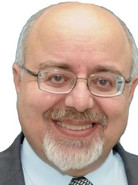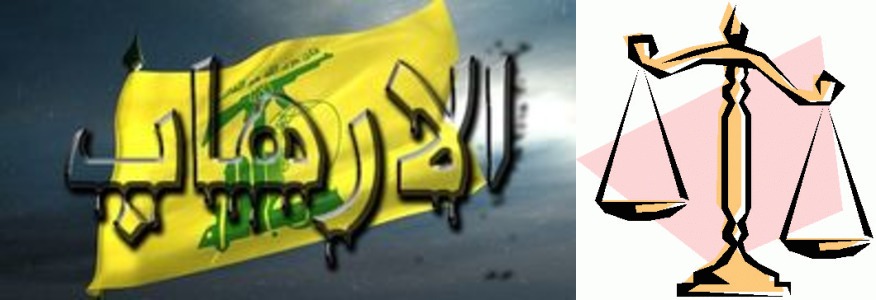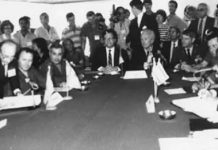Greater Damascus: The Final Touches on the New Demographic Map
Eyad Abu Shakra/Asharq Al Awsat/March 02/18
“Ghouta will fall. That is the message. And when it falls, Idlib must surely be next. And then the Syrians must decide how to break the US-Kurdish hold on Raqqa”, clearly and succinctly, wrote Robert Fisk in ‘The Independent’.
Fisk did not forget to mention that Eastern Ghouta (Northeast and East of Damascus) was now a besieged “enclave”; however, he did not bother to say why it became an “enclave” after 7 years of killing, destruction and systematic population displacement.
Stranger still, that as Fisk used the word ‘Syrians’ in the above opening quote to mean the Damascus regime, ignoring the fact that this Regime was not fighting alone, but was backed throughout its wars of destruction and displacement by the Russian air force and Iran’s sectarian militias brought into Syria from Lebanon, Iraq, Iran, Afghanistan and Pakistan…
Fisk knows more than many the true nature of the Al-Assad family regime, even before the Massacre of Hama in 1982; and yet he regards that Bashar Al-Assad and his brother Maher who is now shelling Eastern Ghouta – with the intention of uprooting and transferring its inhabitants, as was the case with Western Ghouta, Wadi Al-Ajam and Wadi Barada – represent ‘the Syrians’.
Perhaps, he also believes that he who has killed a million Syrians and displacing millions, with direct Russian support, as part of Iran’s settlement grand project connecting Iraq with the Mediterranean coast, not only represent the Syrian people but also Syria’s ‘sovereignty’!
This is a simple example of how some Western experts, circles and media have approached the Syrian debacle; specifically, since former US President Barack Obama decided his administration’s priorities in the Middle East.
The western focus has shifted from the moral duty to support a peaceful popular uprising against a sectarian dictatorship that controlled Syria since the autumn of 1970, to a “war against terrorism” that was allowed to proliferate and commit atrocities, in order to justify aborting the uprising, and rehabilitate dictatorship and ‘non-suicidal’ sectarianism. That latter is the famous term alluding to Iran’s, and used by Obama while marketing his nuclear deal with the Iranian regime.
On the other hand, it would be naïve to think that the ‘Iranian considerations’ were the only ones behind Barack Obama’s decision to stand against the Syrian Uprising. In fact, there is smart and dynamic representative of other interests in Washington, precisely inside the Democratic Party: which is ‘The Israeli Lobby’. This ‘Lobby’ has been comfortable with the Damascus regime’s commitment with ‘peaceful co-existence’ with Israel across the October 1973 ceasefire in in the Golan Heights.
The Israelis know the nature of Al-Assad regime only too well. They understand its strengths, weaknesses and existential priorities. The have also become familiar with its outbidding and escalating belligerent rhetoric while providing Israel one service after another. This is why we have noticed that Israeli pragmatism decided against taking a jump into the unknown; and taking the risk of replacing a ‘useful situation’ with non-guaranteed alternative.
Thus, with intersecting Israeli and Iranian – subsequently, ‘Obamist’ – interests in Syria, the decision was reached to leave the Syrian people to face its own fate.
Meanwhile, in another side of the arena, there were two important players: First, Turkey, the regional power hoping to reclaim its Ottoman imperial role and pose as the protector of Sunni Muslims in an area where Iran and Israel were in the ascendency with American approval. Second, Russia, which under a ‘neo-Tzarist’ rule, has decided to keep its last remaining foothold in the Arab world after losing Iraq in 2003, and Libya in 2011.
Turkey flexed its muscles and resorted to loud rhetoric, while Russia used a more efficient approach combining its UN ‘veto’ and employed diplomacy and misleading negotiations as a cover of changing the rules of engagement on the ground.
Soon enough, Turkey suffered two regional setbacks: the first, when it became involved in inter – Arab conflicts; the second, when it had to beat a retreat in the face of Russian threats after it downed a Russian military aircraft in November 2015 over the Turkish – Syrian borders.
These two setbacks were bound to cost Ankara the initiative, and limit its grandiose geo-political ambitions in Syria; especially, following Moscow’s and Tehran’s exploitation of Washington’s bet on the Kurds.
Given these developments, Ankara realized its limitations, as well as the risks of being accused of ‘supporting terrorism’; and seeing Washington’s rush to bolster secessionist Syrian Kurdish militias, Ankara saw a common cause with Moscow and Tehran that soon resulted in the Astana Process, the first political ‘coup’ against the Geneva Peace Process for Syria.
As for Moscow, and following its gains from Obama’s policy appeasement with Iran, it gained again from the confusion and chaos in Donald Trump’s administration. This has allowed the Russians, while liaising with Israel, to uncover their real ambitions in Syria, and provide the much-needed cover to Tehran and Al-Assad’s regime to carry on their demographic change in the country.
The policy of demographic change has resulted so far in uprooting and displacing the populations of eastern Aleppo, the western and southern suburbs of Damascus, as well as Wadi Barada (the valley of Barada River), with the intention of linking Damascus with Hezbollah-dominated Lebanon to the west.
All that after the mass displacement of the populations of the majority of Homs city neighborhoods, as well as several areas in the provinces of Homs, Hama and Idlib; and under the pretext of fighting ISIS, many parts of the provinces of Raqqa, Deir Ez-Zor, Al-Hasakah, and even Deraa.
Today, when Robert Fist talks with conviction about the imminent fall of Ghouta, and Idlib later on, he does because there are no more illusions, despite the futile haggling taking place in the UN Security Council.
The fact of the matter is that the demographic conspiracy against Syria is fast nearing its completion. The dubious ‘evaporation’ of ISIS, and the rush of secessionist Kurdish militias to hand back the territories they control to the Al-Assad troops and Iranian militias lead by Suleimani and protected by Putin’s air force, only confirm that we are now in the last phase.
What’s next?
Well, logically, what remains of the set ‘scenario’ are determining the details of the Kurdish-American co-operation east of the Euphrates River, and settling the issue of Southern Syria with Israeli input.
The pre-2011 is now dead. This is a painful fact that one needs to accept; however, what is even worse and more dangerous is that we are going through the redrawing of new maps in an increasingly fragile and weak region.
إنجاز الخريطة الديموغرافية لمحيط دمشق
إياد أبو شقرا/الشرق الاوسط اللندنية/الأحد 25 شباط 2018
ببلاغة وإيجاز، كتب روبرت فيسك في صحيفة «الإندبندنت» البريطانية، أمس، ما يلي «ستسقط الغوطة. هذه هي الرسالة. وبعد سقوطها ستليها إدلب حتماً، وبعد ذلك سيتوجب على السوريين تقرير كيف يكسرون قبضة الأميركيين والأكراد على الرقة».
في التقرير لم ينسَ فيسك أن يشير إلى أن الغوطة الشرقية باتت «جيباً» مُحاصراً… لكنه، طبعاً، لم يكلّف نفسه عناء شرح كيف أصبحت هذه المنطقة «جيباً» بعد 7 سنوات من القتل والتدمير والتهجير الممنهج. أما الأغرب فهو أن فيسك سمح لنفسه في العبارة التي بدأتُ بها هذه المقالة – مستخدماً كلمة «السوريين» في سياق الإشارة إلى النظام – تجاهل حقيقة أن النظام لم يحارب بمفرده، بل خاض معه كل معاركه التدميرية والتهجيرية الطيرانُ الحربي الروسي وميليشياتُ إيران المذهبية المجلوبة من لبنان والعراق وإيران وأفغانستان وباكستان…
فيسك يعرف أكثر من كثيرين طبيعة نظام آل الأسد منذ ما قبل مجزرة حماة عام 1982، لكنه مع ذلك يعتبر اليوم أن بشار الأسد وأخاه ماهر الذي يدكّ الغوطة الشرقية تمهيداً لتهجير سكانها – على غرار «منجزاته» في الغوطة الغربية ووادي العجم ووادي بردى – يمثلان «السوريين». ولعله يعتقد أيضاً أن مَن أسهم، بدعم روسي مباشر وفي ظل المشروع الاستيطاني الإيراني المتمدّد من العراق إلى البحر المتوسط، في قتل مليون سوري وتهجير ملايين السوريين… حقاً يمثّل السوريين ويعبّر عن «سيادة» سوريا.
هذا نموذج بسيط لمقاربة بعض العقول والدوائر ووسائل الإعلام الغربية لمحنة سوريا، وبالذات، منذ اختار الرئيس الأميركي السابق باراك أوباما أولويات إدارته في الشرق الأوسط.
لقد تحوّلت كل القراءة الغربية عن الواجب الأخلاقي لدعم انتفاضة شعبية سلمية ضد نظام طائفي تسلّطي أطبق على سوريا منذ خريف 1970، إلى «حرب على إرهاب» كان مطلوباً السماح له بأنه ينمو ويرتكب الفظائع كي يبرّر إجهاض الانتفاضة الشعبية، وإعادة تأهيل التسلط والطائفية «غير الانتحارية» – وفق مصطلح أوباما الشهير عن إيران – في سياق تسويقه للأميركيين اتفاقه النووي مع طهران.
من ناحية ثانية، من السذاجة تصوّر أن الاعتبارات الإيرانية كانت وحدها وراء قرار باراك أوباما في الوقوف ضد انتفاضة السوريين؛ إذ يوجد ممثل مصالح أخرى لا يقل ذكاءً ونشاطاً داخل واشنطن، وتحديداً، داخل الحزب الديمقراطي الأميركي هو «اللوبي الإسرائيلي» الذي كان مرتاحاً لالتزام نظام دمشق بـ«التعايش السلمي» معه عبر خط الفصل بالجولان منذ أكتوبر (تشرين الأول) 1973.
الإسرائيليون حفظوا عن ظهر قلب نظام الأسد، وفهموا مكامن قوته ونقاط ضعفه وأولوياته السياسية الوجودية. هضموا لهجة المزايدة والتصعيد التي اعتادها بينما كان يقدّم لإسرائيل الخدمة تلو الأخرى. ومن ثم، رأينا البراغماتية الإسرائيلية ضد القفز في المجهول. ضد المجازفة بالاستعاضة عن حالة ثبتت منفعتها… ببديل لا يقدم لها أي ضمانات.
وهكذا، مع تقاطع المصالح الإيرانية والإسرائيلية – وبالتالي الأوبامية – على أرض سوريا، اُتخِذ قرار ترك الشعب السوري لمصيره.
في جانب آخر، كان هناك لاعبان مهمان: تركيا، اللاعب الإقليمي الطامح لاستعادة الدور العثماني وتنصيب نفسه حامياً لأهل السنة والجماعة في مناطق تعربد فيها إيران وإسرائيل برضا واشنطن. وروسيا، تحت حكم «قيصري جديد»، التي قرّرت المحافظة على آخر مواطئ أقدامها في المنطقة العربية، بعد انحسار حضورها في العراق بعد 2003 وانتقال ليبيا إلى مزيد من الفوضى بعد 2011.
تركيا دخلت الساحة بعرض عضلات ولهجات تهديد مرتفعة، بينما اختارت روسيا أسلوباً أكثر فاعلية مزجت فيه بين فرض «الفيتو» والتستّر بالدبلوماسية والتضليل التفاوضي لتغطية تغييرها قواعد اللعبة العسكرية على الأرض.
بعد ذلك، مُنيت سلطات أنقرة بنكستين إقليميتين: الأولى، عندما سمحت لنفسها بالدخول طرفاً في النزاعات العربية – العربية، والثانية، عندما تراجعت أمام التهديدات الروسية في أعقاب حادث إسقاط الطائرة الحربية الروسية في نوفمبر (تشرين الثاني) 2015 فوق المنطقة الحدودية السورية التركية (حدود لواء الإسكندرونة/ هتاي). وكان من نتيجة هاتين النكستين فقدان أنقرة زمام المبادرة وتقليص طموحها الجيوسياسي في سوريا، ولا سيما بعد استغلال موسكو وطهران الرهان الأميركي على العامل الكردي.
إذ ذاك أدركت سلطات أنقرة حدود قدراتها، وأيضاً مخاطر التهم الموجهة لها «بدعم الإرهاب». وفي المقابل، رأت بعد اندفاع واشنطن لدعم الميليشيات الانفصالية الكردية السورية قواسم مصلحية مشتركة بينها وبين موسكو وطهران… سرعان ما أثمرت مسار آستانة، الذي شكّل عملياً أول «انقلاب» سياسي على مسار جنيف. أما موسكو، فبعد استفادتها من مُسايرة أوباما لإيران، استفادت مُجدّداً من ارتباك إدارة دونالد ترمب وتخبّطها في أزماتها الداخلية داخل دهاليز واشنطن. وكشفت – بالتنسيق مع إسرائيل – عن طموحاتها في سوريا، وأمّنت التغطية اللازمة للإيرانيين ونظام الأسد للمضي قدماً في التغيير الديموغرافي في سوريا.
وبموجب هذه السياسة جرى تهجير حلب الشرقية وضواحي دمشق الغربية والجنوبية، ومنطقة وادي بردى، تمهيداً لوصل دمشق بالعمق اللبناني الواقع تحت هيمنة «حزب الله»، وذلك بعد تهجير معظم أحياء حمص ومناطق عدة في ريفها وريف حماة وريف إدلب. وبحجة «داعش» – المجهولة النسب والمُلتبسة الولاء – امتد التهجير إلى محافظات الرقة ودير الزور والحسكة، بل، وحتى درعا.
اليوم عندما يتكلم روبرت فيسك جازماً عن إسقاط الغوطة… ثم إدلب، فهو لأنه ما عادت هناك أسرار. ما عادت هناك أوهام، رغم مساومات مجلس الأمن الدولي.
ذلك أن المؤامرة الديموغرافية على سوريا تقترب الآن من اكتمال فصولها. و«تبخّر» «داعش» بقدرة قادر، وتسليم الانفصاليين الأكراد مناطقهم لجيش آل الأسد وميليشيات سليماني وطيران بوتين، من هذه الفصول الأخيرة.
ماذا بعد؟ المنطق يقول إنه لم يتبقَّ لإكمال «السيناريو» سوى ضبط تفاصيل هوية شرق الفرات بتحديد العلاقة الكردية – الأميركية، وحسم أمر الجنوب السوري في ظل الحسابات الإسرائيلية.
سوريا ما قبل 2011 انتهت، وهذا واقع مؤلم يجب الاعتراف به. لكن ما هو أخطر تداعيات البدء برسم خرائط إقليمية جديدة لمنطقة تزداد هشاشة ووهناً بمرور كل يوم!






















